Some people think of growing marijuana (or any other plant, for that matter) and only picture plants living in soil. The truth of the matter, however, is that there are a wide variety of growing mediums that can work well for marijuana plants.
There are many reasons why you would choose one type of growing medium over another; to make an informed decision, it’s important to understand the basic aspects of each one.
Below we will compare different grow media for marijuana.
The classic option for most growers and possibly all beginning marijuana growers, soil has many reasons for being popular. These reasons include the fact that it is a natural ingredient and is very easy to find. Soil has the added bonus of being really easy to use, which is why it is popular amongst beginners in particular.
Soil leaves a lot of room for error. If a grower does something terribly wrong, their marijuana plants won’t simply die immediately. Instead, the soil allows them to have some sort of cushion, no matter what type of shock they are going through. This is much less daunting than some of the other, less forgiving grow media.
The best type of soil to use is a potting compost that has been sterilized and is not packed too tightly. It also should be based in something other than peat. This will allow your marijuana plants to get plenty of the nutrients they need to grow right off the bat.
Download my free Marijuana Grow Bible and learn how to grow marijuana in soil
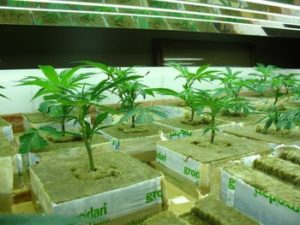
Although soil is probably the most popular growing medium, rockwool is also very effective and useful in its own ways. Rockwool itself actually has its beginnings in insulation during the 1960s.
During that same decade, there was some research done on how plant growth and rockwool might go together, and the results were extremely positive. Since then, rockwool has been available to growers everywhere to buy in cubes of various sizes.
In terms of its makeup, rockwool is not naturally occurring. It is made from metal oxide or mineral fiber that is combined with heat and pressure. Rockwool is extremely popular among hydroponics growers, due in part to the fact that it takes in lots of water and air with plenty of breathability. Its dense fibers also allow for stabilization of the plant, making it an excellent choice for hydroponics.
If you are growing with rockwool, begin with cubes of 1 inch per side. Then, a “transplant” will simply consist of fitting that smaller cube into a bigger cube — easy and hassle-free! One of the only downsides of rockwool is the fact that it contains large amounts of metals, meaning it could react somewhat to nutrients.
You should also make sure that you have pH-balanced the rockwool before planting your marijuana plants. For more tips about growing in rockwool make sure to download my free marijuana grow bible at this link.
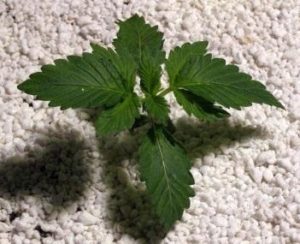
If you haven’t seen it before, perlite resembles the tiny rocks that sit at the bottom of a fish tank. In fact, it is a type of amorphous volcanic gas in granule form, having been expanded with heat first. The beauty of perlite is you don’t need to neutralize its pH level because it is already pH neutral. It retains water really well but is still porous, allowing oxygen to reach your marijuana plants’ roots.
Perlite is particularly useful for transplantations, due in part to the fact that it works in containers really well. The only negative side of perlite is its dusty quality, which can cause problems in the filters of hydroponics systems. It can also cause lung issues if you breathe in this dust, so proceed with caution.
You can also use perlite to help germinate your seeds faster. Read more…
Whatever you do, wash perlite before use because it could be fertilizer-treated if it has been purchased from a garden center. Additionally, perlite doesn’t stabilize the plant very well (unlike rockwood). For that reason, using it with another type of medium is recommended.

Like perlite, vermiculite is a light clay and mica product that, like rockwool, has undergone heat expansion. Although its lightness allows for excellent water retention and oxygen access, like perlite it also does not offer much support for marijuana plants or their roots. For this reason, combining it with another type of medium is a good idea.
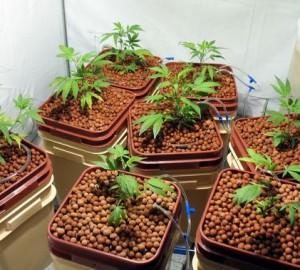
Clay is most often used in the form of pellets, or LECA (lightweight expanded clay aggregate). These pellets have been treated with heat, allowing them to expand and become more porous than clay naturally would be.
Clay pellets are extremely common to use for marijuana growers, due in part to the fact that they are sterile and pH neutral, and they can be reused time and time again (as long as you re-sterilize them in between uses). They provide good stability but also allow for proper water drainage and aeration.
Because the clay pellets are so porous, good bacteria can grow in this medium. You should wash the clay pellets when you buy them before use and then wash them again to make them safe and sterile for later uses. More tips in my free Marijuana Grow Bible at this link here.
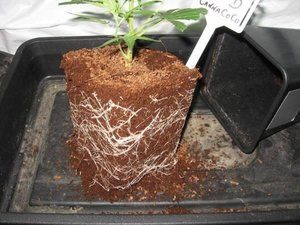
Coco coir, although previously not commonly used, is now gaining in popularity. This is due in large part to its characteristics that make it an excellent choice. It is reusable, like clay pellets, and it doesn’t break down quickly (meaning it can be reused many times before it needs to be discarded).
Coco coir is made from coconut husk fibers. Peat moss is the alternative, but people who might normally use peat moss prefer coco coir because it is far more environmentally friendly (you don’t have to ruin a bog to make it).
Coco coir allows for good drainage, proper aeration, and even good water retention. There’s a reason why everyone prefers coco coir these days.
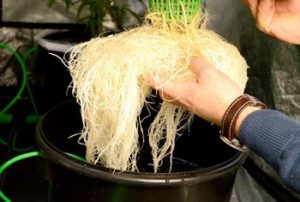
Hydroponic systems involving growing marijuana plants without any kind of soil at all, most often using one of the other types of media listed above. Although it can be tricky for beginning growers, using hydroponics can speed up your plants’ growth and lead to the highest yield possible because the nutrients will be directly into the water, meaning they are essentially going straight to your plants’ roots.
The fact that the nutrients go straight to the roots means they can grow faster, achieve higher yields, and will even have fewer pest or mold issues due to the fact that they are growing in water. There are a variety of methods of hydroponics growing, all of which require plenty of research and even practice to do properly. When done correctly, however, hydroponics growing has no match.
Read this mega article that covers all the possible hydro grow setups.
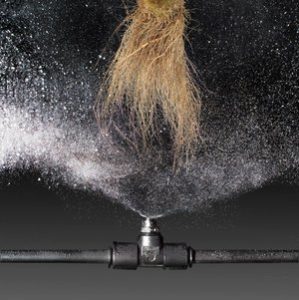
An aeroponic growing system is a type of system similar to hydroponics, except that the roots of your marijuana plants are actually suspended in the air rather than sitting in water. There is no medium to speak of unless you count air as a medium.
The way the roots of marijuana plants receive the nutrients they need in an aeroponics system is through a spray of water filled with nutrients. Because there is so much oxygen in this environment, the microbes that are on your marijuana plants will be able to take in the nutrients and “feed” them to your marijuana plants in a way that allows them to enter straight into the plant’s circulatory system.
If extra carbon dioxide is also included in the aeroponics setup, the growth will be sped up even more. The key to a healthy aeroponics system is the spraying of your plants’ roots. The spray needs to be high pressure, and switching from on and off.
Check how to make a cheap aeroponics setup in my free grow bible at this link.
The intervals at which they are turned on or off are extremely important for your plants’ growth and the success of the system overall. During the off interval, for example, the roots have time to take in the nutrients that they were sprayed with. Without the off interval, your plants might become overwhelmed.
Aeroponics has a greatly reduced likelihood of certain issues like root rot occurring, which is part of the reason it is so appealing to many marijuana growers. That being said, it is certainly not a recommended grow medium for people who have not grown marijuana before or are still in their first few seasons of growing marijuana.
It is also not a good idea even for veteran marijuana growers if they are not technically inclined. There is a lot of technical work involved in an aeroponics system, whether it’s fixing or replacing certain parts (misters, pumps, hoses, and so on) or simply figuring out how to set it up in the first place.
Like a hydroponics system, aeroponics can be extremely effective — but there is no room for error like when you grow in soil or other such media. For that reason, even if you are a veteran grower who is extremely technically inclined, proper research needs to be done to create a successful aeroponics setup.
No matter what medium you choose for your marijuana setup, it’s important to have a complete understanding of the type you are using. Even the most basic soil setup still requires proper care and preparation to be effective. As long as you put in the effort, you should have a successful harvest. Happy growing!
by Robert Bergman
www.ilovegrowingmarijuana.com
